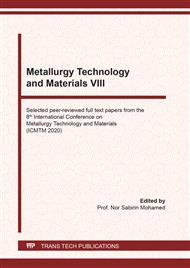[1]
M. Pracella, Md.M. Haque, M. Paci, V. Alvarez, Property tuning of poly(lactic acid)/cellulose bio-composites through blending with modified ethylene-vinyl acetate copolymer, Carbohydr. Polym. 137 (2016) 515-524.
DOI: 10.1016/j.carbpol.2015.10.094
Google Scholar
[2]
V. Gigante, L. Aliotta, V.T. Phuong, M.B. Coltelli, P. Cinelli, A. Lazzeri, Effects of waviness on fiber-length distribution and interfacial shear strength of natural fibers reinforced composites, Compos. Sci. Technol. 152 (2017) 129-138.
DOI: 10.1016/j.compscitech.2017.09.008
Google Scholar
[3]
J.A.Á. Ramírez, J. Bovi, C. Bernal, M.I. Errea, M.L. Foresti, Development of poly(lactic acid) nanocomposites reinforced with hydrophobized bacterial cellulose, J. Polym. Environ. 28 (2020) 61-73.
DOI: 10.1007/s10924-019-01581-1
Google Scholar
[4]
F. Luzi, E. Fortunati, A. Jiménez, D. Puglia, D. Pezzolla, G. Gigliotti, J.M. Kenny, A. Chiralt, L. Torre, Production and characterization of PLA_PBS biodegradable blends reinforced with cellulose nanocrystals extracted from hemp fibres, Ind. Crops Prod. 93 (2016) 276-289.
DOI: 10.1016/j.indcrop.2016.01.045
Google Scholar
[5]
S. Djellali, N. Haddaoui, T. Sadoun, A. Bergeret, Y. Grohens, Structural, morphological and mechanical characteristics of polyethylene, poly(lactic acid) and poly(ethylene-co-glycidyl methacrylate) blends, Iran. Polym. J. 22 (2013) 245-257.
DOI: 10.1007/s13726-013-0126-6
Google Scholar
[6]
M. Perić, R. Putz, C. Paulik, Influence of nanofibrillated cellulose on the mechanical and thermal properties of poly(lactic acid), Eur. Polym. J. 114 (2019) 426-433.
DOI: 10.1016/j.eurpolymj.2019.03.014
Google Scholar
[7]
R.S. Araújo, L.C. Ferreira, C.C. Rezende, M.F.V. Marques, M.E. Errico, R. Avolio, M. Avella, G. Gentile, P. Russo, Poly(lactic acid)/cellulose composites obtained from modified cotton fibers by successive acid hydrolysis, J. Polym. Environ. 26 (2018) 3149-3158.
DOI: 10.1007/s10924-018-1198-3
Google Scholar
[8]
S.H. Sung, Y. Chang, J. Han, Development of polylactic acid nanocomposite films reinforced with cellulose nanocrystals derived from coffee silverskin, Carbohydr. Polym. 169 (2017) 495-503.
DOI: 10.1016/j.carbpol.2017.04.037
Google Scholar
[9]
N. Jamaluddin, T. Kanno, T.A. Asoh, H. Uyama, Surface modification of cellulose nanofiber using acid anhydride for poly (lactic acid) reinforcement, Mater. Today Commun. 21 (2019) 100587.
DOI: 10.1016/j.mtcomm.2019.100587
Google Scholar
[10]
T.C. Nguyen, C. Ruksakulpiwat, Y. Ruksakulpiwat, Effect of cellulose nanofibers from cassava pulp on physical properties of poly(lactic acid) biocomposites, J. Thermoplast. Compos. Mater. (2019) 1-15.
DOI: 10.1177/0892705718820395
Google Scholar


